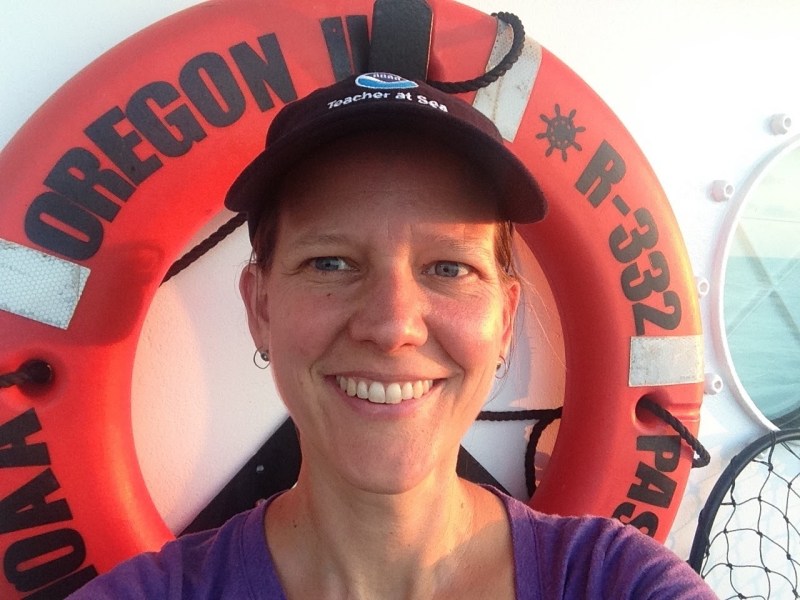With an animated grin splitting across her face, Kate Schafer ’92 shows me a bright blue notebook that she started to fill in last year — its entries are filled with thoroughly annotated hand drawings depicting her examinations of nature. An entry she is particularly excited about documents the changing height of the tide — the result of hours of careful observation.
Schafer’s hobby of nature-journaling began in the early days of the pandemic last year as a way to take time away from her computer.
“It has transformed my experience of places and what I see,” Schafer said about nature-journaling, which enables her to appreciate nature in a new way.
Starting nature-journaling is not the only result of Schafer’s reflecting on her passion for environmental science. This coming school year, she will begin a new teaching job at the Sequoyah School in Pasadena, Calif., which specializes in interdisciplinary, project-based teaching with a focus on environment protection.
While she described the job change as “exciting” and “a new adventure,” the milestone moments that shaped Schafer’s career began in Woods Hole, Mass., where she took a marine biology class; fittingly, Schafer returned to the same town to conduct our interview.
Between snorkeling sessions and studying the organisms that inhabited the Woods Hole waters, Schafer discovered the mysterious world of marine biology.
“I always loved the ocean,” Schafer said. “But I never really thought about what was actually in the water, so that really prompted my interest and excitement about knowing more about the ocean ecosystems.” Led by her interest and excitement, Schafer was attracted to Stanford’s Hopkins Marine Station, which allows undergraduates to take advanced marine biology courses.
Schafer’s second moment of discovery came in Jamaica, where she helped set up a marine-protected area. Jumping into the coral reefs of the warm, clear Jamaican waters, she was struck by their beauty — but also sought to learn and research more about the reefs.
This experience, coupled with witnessing the dramatic “before and after” comparison of coral reef bleaching in Belize, inspired her to research coral reef ecology for her doctoral dissertation.
After receiving her Ph.D. at the University of California, Berkeley, Schafer pursued several jobs, including teaching on a boat in San Francisco Bay. Through the process, she discovered her love for teaching — her “third moment.”
“I really missed the long-term relationships that I developed with students,” she said. “I really missed getting to know people in a more substantial way.” Apart from her love for teaching, Schafer credited the energy of high schoolers as another reason she became a high school teacher.
The opportunity to realize her love for education and science came as a job offer from The Harker School in San Jose. During her 15 years there, she taught and developed several courses, including biology, marine biology, AP Environmental Science and a research class. As a part of a summer ecology course offered by Harker, Schafer traveled with her students to southeastern Alaska.
“There are things [in Alaska] that are reminiscent of Northern California, but in a bigger, more profound way.” Schafer said. “I feel this tug and this need to be there.”
Having called Northern California her home since her time at Stanford, Schafer said she is ready to embark on a new adventure in SoCal.
As the California wildfires reddened the Bay Area’s sky in 2020, the urgency of the climate crisis prompted Schafer to reflect on what was most important to her, and how she could make the biggest impact. The result: the start of a new teaching position at Sequoyah School in Pasadena, Calif.
Students at Sequoyah School, a K-12 day school, embark on multiple camping and backpacking trips each year. Locations range from the Grand Canyon to Costa Rica to the Colorado River. These interactive, hands-on learning opportunities spoke to Schafer.
People are more “connected to nature and more inclined to … improve conditions in the world if they have those experiences,” she said.
Apart from off-campus trips, Sequoyah School also hosts a Social Innovation program, in which students pursue in-depth research and social projects to support one of the UN’s 17 Sustainable Development Goals. Sequoyah School also offers five- and 10-week interdisciplinary electives that allow students to explore environmental protection through the lens of science, English, history or another department.
These interdisciplinary electives, Schafer said, remind her of Stanford’s programs.
“One of the amazing things that Stanford has done is create these interdisciplinary programs that really draw on expertise from a lot of different departments.” Schafer said. “Getting to have those experiences in college where people with different backgrounds are coming together sets students up for success when they go out into the real world.”
